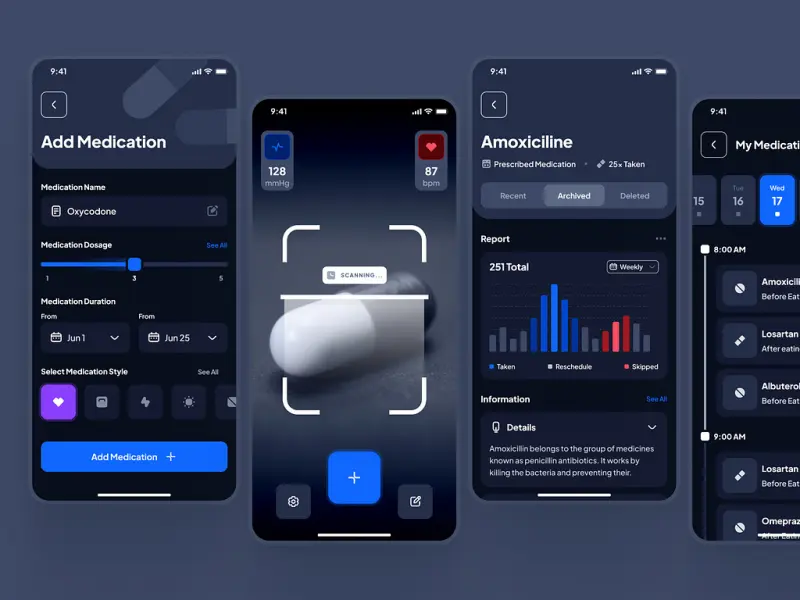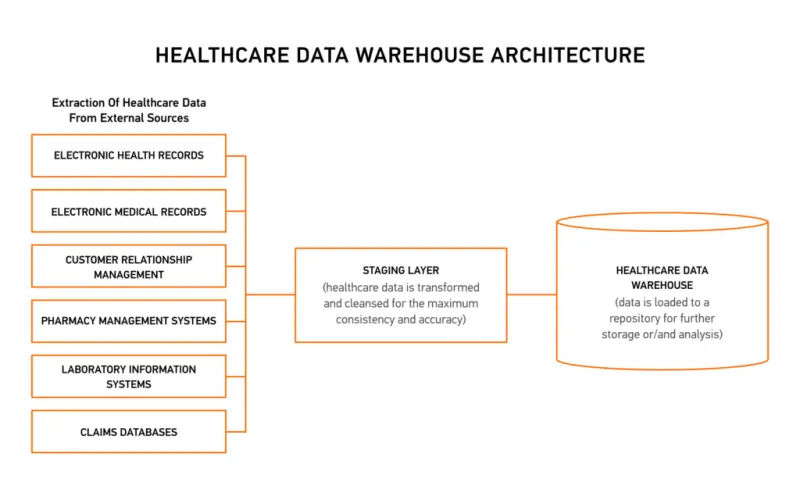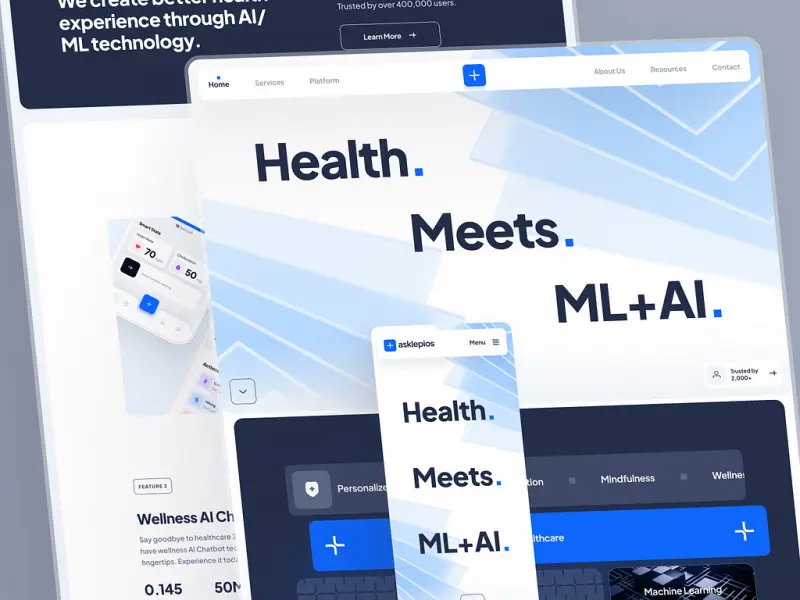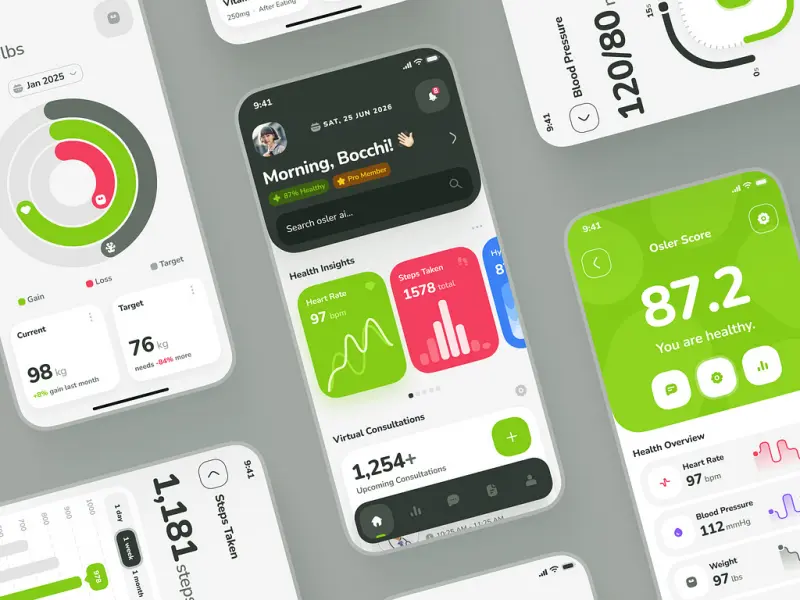The Ultimate Guide to Healthcare Data Warehouse
- TECHVIFY Team
- 0 Comments
It’s paradoxical that despite holding vast amounts of data, the healthcare industry continues to struggle with misdiagnosis, subpar care quality, fraud, and inefficiencies. The underlying cause is clear—stringent regulations, ethical dilemmas, and high research costs often leave data trapped in isolated, outdated systems.
A healthcare data warehouse (DWH) emerges as a transformative solution, particularly in fields like drug discovery, cancer treatment, and disease prediction. This pivotal advancement enables early disease detection, identifies at-risk patients, and accelerates both administrative and clinical workflows.
Research indicates that the global healthcare data warehousing market could reach around $8 billion by 2030. It’s no wonder major players are increasingly adopting data warehouses in healthcare.
This article delves into the essentials of data warehousing, covering its benefits, architectural models, and implementation strategies for your healthcare organization.
I. Understanding Data Warehousing in Healthcare
A healthcare data warehouse functions as a centralized hub for housing information gathered from electronic health records (EHRs), electronic medical records (EMRs), lab databases, and more. This data undergoes a transformation to align with a standardized format, facilitating streamlined analysis.
A clinical data warehouse acts as a definitive resource for healthcare organizations, aiming to provide precise data for enhanced decision-making. It offers a solid foundation for data analysis, enabling the use of data mining techniques to uncover patterns, trends, and relationships to address complex healthcare challenges.
Health Data Warehouse Example
II. Advantages of Data Warehousing in Healthcare
The primary benefits of a healthcare data warehouse are its ability to manage, analyze, and derive insights from vast amounts of data, while also maintaining historical data for predicting future trends and outcomes. Here are seven key advantages:
Enhances Data-Driven Clinical Decisions
Effective medical intervention relies on timely and accurate diagnoses. With just a few clicks, healthcare professionals can access and analyze pertinent data, gaining insights that inform prognoses and clinical decisions. A structured data warehouse eliminates the chaos of disorganized data, allowing for efficient analysis. For instance, machine learning can leverage extensive data to predict outcomes for rare conditions like amyloidosis.
Boosts Data Reporting and Analytics
Beyond being a centralized repository, a healthcare data warehouse serves as a dynamic analytics tool, generating precise and timely reports. Clinicians can compare a patient’s current status with their history, monitor administrative health metrics, and present data-driven reports to stakeholders, enhancing clinical research and identifying problem areas.
Streamlines Insurance Claims and Payouts
Managing insurance claims is a significant challenge for hospitals and pharmacies. A data warehouse facilitates quick processing of claim-related data, helping healthcare organizations verify payout schemes, prevent fraud, and address other issues.
Still want to see more Healthcare articles? Check here:
Enhances Personalized Patient Care
Achieving patient wellness is the ultimate goal. Data warehouses enable comparison of symptoms, identification of causes, and determination of effective treatments. By integrating data from investigations and follow-ups, healthcare providers gain a comprehensive view of a patient’s medical journey, bridging gaps between providers and patients, improving care standards, and boosting satisfaction. Moreover, the cost of accurate diagnosis is high, even for insured patients. Data analytics from a warehouse provide insights into disease patterns, allowing doctors to refine treatment plans to meet individual needs, avoiding unnecessary expenses and invasive procedures.
Ensures HIPAA Compliance and Data Security
Protecting patient information is paramount. To comply with HIPAA, healthcare organizations use data warehouses to set permissions that restrict access to sensitive data. By configuring security at both the business intelligence and data analytics levels, only non-sensitive data is shared in reports and dashboards.
Eliminates Disparate Data and Enhances Integrity
Like physical warehouses, data in a warehouse is organized and accurate. Unlike data lakes, which are vast collections of unstructured data, warehouses use ETL and ELT processes to maintain data integrity, ensuring correct transformation and loading.
Facilitates Data-Based Resource Planning
A key benefit of data warehousing is its ability to provide insights for resource optimization, interdepartmental communication, and financial efficiency. Hospitals, as businesses, aim to profit while minimizing costs. Data-driven resource planning helps eliminate unnecessary spending and improve profitability.
Looking to Outsource Development?
Contact TECHVIFY – Vietnam’s Leading Offshore Software Development & Outsourcing Company, for consultation and development services.
III. Critical Features of a Healthcare Data Warehouse
Healthcare data warehouses (HDWs) require careful handling to ensure security and seamless integration with various data sources. Each HDW is customized to meet the specific needs of an organization, so key features may vary depending on its intended use.
However, there are common elements to consider for any HDW model. A fully functional HDW should include:
-
Comprehensive Data Integration: HDWs must consolidate data from EHRs, HR management, ERP systems, claims management, and public health databases. This integration involves big data and streaming data, supporting advanced medical data loading and querying. Ensure your HDW can standardize data from both internal and external sources.
-
Ensuring Data Quality: Effective HDWs have quality controls to ensure data accuracy, completeness, and consistency. Built-in processes like data cleaning and validation promote standardization across data points.
-
Future-Proof Scalability: While your organization might start with a simple HDW setup, increased usage will require scalability. A robust HDW should accommodate future data growth, helping you manage larger data loads effectively.
-
Robust Security and Privacy: Properly designed HDWs include encryption and access controls to protect patient data, adhering to security and privacy protocols. Role-based permissions ensure compliance with laws such as HIPAA.
-
Enhancing Interoperability: Efficient HDWs eliminate fragmented workflows, fostering collaboration among care teams for comprehensive care. Your HDW should facilitate seamless care coordination.
When choosing a single or multi-data platform provider, ensure they offer these features. Alternatively, if building an in-house solution, incorporate these elements to maximize analytical capabilities and achieve the best return on investment for your efforts.
IV. Healthcare Data Warehouse Architecture
The architecture of a healthcare data warehouse is a sophisticated framework that outlines its overall design. Before selecting an architecture, consider factors like the size of your organization, business objectives, and area of focus. Consulting with healthcare data warehouse vendors is advisable to choose the right model for your needs.
Let’s explore the two predominant architectural models in healthcare data warehousing: individual and enterprise data warehousing.
Healthcare Data Warehouse Architecture
1. Focused Data Warehousing
An individual data warehouse, often called a data mart, contains various data subsets and targets a specific functional area within a healthcare organization. Though it can be seen as an isolated repository, it’s more accurately a streamlined data warehouse version intended for specific departments, such as pharmacy, outpatient care, or radiology.
The advantage of a focused data warehouse is that it allows healthcare units to begin analyzing targeted data, like rare diseases, and expand as needed. However, data marts typically draw from fewer sources compared to the enterprise model. This approach is ideal for small to midsize healthcare providers looking to address specific challenges promptly.
Individual data warehouses come in three varieties: independent, dependent (part of an enterprise model), and hybrid data marts.
2. Comprehensive Enterprise Warehousing
The enterprise data warehouse (EDW) model is a comprehensive solution for healthcare providers aiming to store and analyze extensive data from multiple sources. This complex model includes several layers:
-
Data Source Layer
This layer gathers both internal and external data from crucial research sources. In hospitals, data might come from ERP systems, EMRs/EHRs, lab portals, insurance claim software, pharmacy management systems, polls, clinical sources, surveys, CRM systems, and more. -
Staging Layer
Known as the staging zone, this layer temporarily holds the influx of diverse data from the source layer. Here, data aggregation, anonymization, and normalization occur using ETL (extract, transform, load) or ELT (extract, load, transform) methods. Both aim to produce well-structured, high-quality data free of duplicates and errors. -
Data Storage Layer
This central layer houses structured data processed via ETL/ELT in the cloud, SQL databases, or hybrid databases, awaiting analysis. A key benefit is that this layer can also accommodate individual data marts, both dependent and hybrid, allowing data to be sorted for specific departmental use. -
Data Reporting and Analytics Layer
Also known as the business intelligence (BI) layer, this is where analytical tools and third-party integrations like machine learning, BI, and data lake software come into play. Here, data is analyzed using statistical methods, data mining, visualizations, graphs, charts, and report summaries.
Imagine a diagram illustrating what an enterprise data warehouse for healthcare entails:
V. Implement a Data Warehouse for Healthcare Organizations
Implementing a healthcare data warehouse is a complex process, especially for executives without a tech background. Here’s a detailed roadmap to guide you from start to finish.
Step 1: Initial Planning Phase
This foundational stage is crucial for setting the project’s direction. It involves:
- Engaging with relevant parties to understand their requirements and expectations, ensuring alignment with organizational goals.
- Conducting a thorough assessment of current data management practices to pinpoint inefficiencies or gaps.
- Evaluating the existing technological environment to determine compatibility and identify necessary upgrades.
- Developing clear objectives and key performance indicators to measure the project’s success.
- Establishing a realistic budget that considers scope, resources, and potential challenges.
- Creating a detailed blueprint that outlines the data warehouse’s architecture, aligning with stakeholder needs and organizational goals.
Healthcare Data Warehouse
Step 2: Designing the Framework
This stage focuses on creating the technical blueprint. Decide how data from various sources will be integrated, ensuring seamless interoperability and data flow. Develop a conceptual or logical data model that outlines the structure and relationships within the data warehouse. Aggregate data into OLAP cubes to facilitate multidimensional analysis and enhance decision-making capabilities.
Identify all potential data sources and plan for data extraction and transformation using ELT or ETL processes. Choose and design the appropriate data models to support the organization’s analytical requirements. Plan required integrations with existing systems to ensure data consistency and accessibility. Establish procedures for monitoring data integrity and validating data accuracy over time.
Step 3: Development Execution
This phase involves the tangible building of the data warehouse. Set up the necessary hardware and software infrastructure to support the data warehouse’s operations. Develop the software components and integrate them with existing IT systems, ensuring seamless operation. Implement the project in phases, allowing for testing and adjustments while keeping stakeholders updated on progress. Develop user-friendly applications that allow stakeholders to interact with the data warehouse, ensuring ease of access and usability.
Step 4: Testing and Launch
Ensure readiness for deployment through rigorous testing. Deploy the designed schemas and data models on your chosen storage layer, whether on-premise or cloud-based. Conduct comprehensive testing to identify and address any functional issues, ensuring the system performs as expected. For on-premise solutions, maintain a dedicated team to resolve any technical problems quickly. Consider cloud-based solutions like Databricks and Snowflake for scalable and flexible deployment.
Step 5: Continuous Improvement
Ongoing maintenance and enhancement are vital. Regularly update the data warehouse based on user feedback and technological advancements to maintain its relevance and efficiency. Incorporate new medical metrics and data points as they emerge, ensuring the data warehouse evolves with industry trends. Provide ongoing training and support to ensure users can effectively leverage the data warehouse’s capabilities. Continuously monitor performance to optimize processes and address any emerging issues promptly.
VI. Examples of Data Warehouse in Healthcare
1. Mayo Clinic
Mayo Clinic utilizes a data warehouse to integrate clinical, genomic, and imaging data. This helps in advancing personalized medicine and improving patient care.
Features:
- Comprehensive patient data integration.
- Supports clinical research and personalized treatment plans.
2. Kaiser Permanente
Kaiser Permanente has developed a HealthConnect data warehouse. It integrates EHRs from their facilities to enhance patient care and operational efficiency.
Features:
- Streamlined patient record access across facilities.
- Supports population health management and preventive care.
Healthcare Software
3. Cleveland Clinic
Cleveland Clinic’s data warehouse aggregates data from various clinical systems to improve patient outcomes and support clinical research.
Features:
- Advanced analytics for patient care improvement.
- Facilitates clinical trials and research studies.
4. Intermountain Healthcare
Intermountain Healthcare employs a data warehouse to manage clinical and operational data, supporting evidence-based practices and improving healthcare delivery.
Features:
- Data-driven decision-making in clinical practices.
- Enhances operational efficiency and patient safety.
5. Cerner Corporation
Cerner’s data warehouse solutions help healthcare organizations manage and analyze large volumes of clinical and operational data to improve care delivery.
Features:
- Comprehensive data integration and analytics.
- Supports clinical decision support systems and population health management.
Conclusion
Embracing a healthcare data warehouse is crucial for overcoming industry challenges like misdiagnosis and inefficiencies. By leveraging this transformative technology, healthcare organizations can enhance decision-making, streamline processes, and improve patient outcomes. As the market continues to grow, now is the perfect time to invest in a robust data warehousing solution.
Ready to revolutionize your healthcare business? Reach out to TECHVIFY for expert consultation and development services. Let’s work together to unlock the full potential of your data.
TECHVIFY – Global AI & Software Solutions Company
For MVPs and Market Leaders: TECHVIFY prioritizes results, not just deliverables. Reduce time to market & see ROI early with high-performing Teams & Software Solutions.
- Email: [email protected]
- Phone: (+84)24.77762.666









